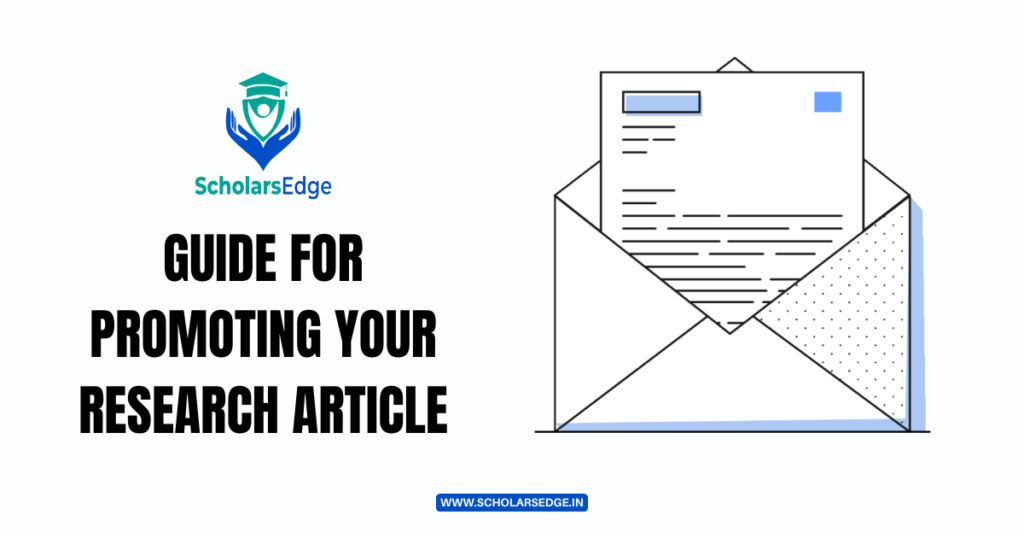
Introduction
Promoting your research paper is crucial to ensure its impact. By sharing your findings, you can increase the visibility within the academic community and beyond. Promotion helps establish expertise, foster collaboration, and networking opportunities. This enhances your professional reputation and credibility. Additionally, broader dissemination aids in societal awareness, potentially influencing policy or practical applications. In today’s digital age, promotion through social media, online platforms, and conferences amplifies your work and contributes to citation rates. Ultimately, effective promotion maximises the potential societal and academic influence of your research, advances your career, and fosters a wider understanding of your contributions. On this blog, we will guide you to the best ways to enhance the visibility of your research paper.
Crafting a Compelling Abstract
Crafting a compelling abstract concisely summarises the key aspects of your research. Beginning with a concise problem statement, followed by methods, results, and conclusions. Use clear language, avoiding jargon, to make it accessible to a broad audience. This highlights the significance of our findings and their potential impact. Emphasise key contributions and innovation, and engage readers from diverse backgrounds. Maintain brevity while conveying the essence of your work, enticing the audience to explore it further. A well-structured abstract serves as a concise gateway, attracting attention and conveying the importance of research, making it a critical tool for effective communication and engagement.
Leveraging Social Media
Leveraging media amplifies the impact of research by reaching wider audiences beyond academia. Social media platforms such as Twitter and LinkedIn facilitate rapid dissemination by connecting researchers and professionals globally. Engaging in visuals and concise messages makes complex findings accessible, fostering interest. Media coverage from reputable sources enhances credibility and attracts the attention of diverse communities. Multimedia content, including podcasts and webinars, caters to different learning styles and broadens its accessibility. Collaborating with institutions and utilising online platforms extends the visibility. Overall, media leverage transforms research into dynamic conversation, cultivating a broader understanding and interest in your work, ultimately increasing its societal and academic influence.
Collaborating with Institutions
Collaboration with institutions for research paper promotion involves strategic partnerships. Engage university press offices, providing them with compelling press releases and summaries. Foster relationships with research centres and collaborate on joint communication efforts. Seek endorsements or features on institutional websites and newsletters. Utilise institutional social media channels for wider visibility. Offer to present your findings at relevant events or seminars hosted by institutions. Coordinated efforts enhance the reach and impact of research by leveraging institutional credibility. Aligning your promotion strategy with institutional goals strengthens collaboration, fosters mutual benefits, and amplifies the dissemination of your research within academic and broader communities.
Creating Multimedia Content
Creating multimedia content enhances research promotion by catering to diverse audiences. Podcasts and webinars offer accessible auditory formats, allowing for in-depth discussions beyond written text. Infographics and visual abstracts distil complex information into visually appealing, shareable formats and increase engagement in social media. Visual content is more memorable, aiding comprehension and retention. Multimedia enable researchers to connect with a broader audience, including those outside the academic sphere. Incorporating various formats not only expands reach, but also accommodates different learning preferences, making your research more approachable and increasing its potential impact across a spectrum of audiences.
Utilising Email Campaigns
E-mail campaigns serve as targeted and direct communication tools for research promotion. Building an email list allows you to reach a specific audience such as colleagues, collaborators, and interested professionals. Craft personalised and concise emails with a compelling subject line, highlighting the key findings and significance of your research. Including links to your paper, related resources, or multimedia content encourages engagement. Regular updates through email keep your network informed about your work progress, fostering ongoing interest. In addition, emails can prompt collaboration, citations, or feature opportunities, enhancing the overall impact and visibility of research within a segmented and interested audience.
Networking at Conferences
Conferences play a pivotal role in promoting research. Engaging with peers, experts, and potential collaborators offers opportunities for knowledge exchanges and professional relationships. During poster presentations or sessions, discussing research attracts attention and invites valuable feedback. The exchange of business cards and contact information facilitates continued communication. Networking enhances visibility and increases the likelihood of collaboration, joint projects, or future citations. It also opens doors to presenting your work at other events, thus expanding its reach. Building a network within one’s field creates a supportive community, where the collective promotion of research elevates the impact of individual contributions, contributing to academic growth and recognition.
Conclusion
In conclusion, effective promotion is an effective strategy for maximising the impact of research articles. Crafting compelling abstracts, leveraging media, collaborating with institutions, creating multimedia content, utilising email campaigns, and networking at conferences collectively amplifies a paper’s reach. By embracing diverse communication channels, researchers can transcend disciplinary boundaries and engage broader audiences. This not only enhances academic influence, but also contributes to societal awareness and application. As the scholarly landscape evolves, the proactive promotion of research becomes integral, fostering collaboration, recognition, and deeper understanding of the collective knowledge base. Strategic promotion is not just a formality; it is also an essential catalyst for advancing research in a dynamic and interconnected world.
FAQs About Promoting Research Article
Why is research promotion important?
Research promotion increases visibility, expands academic influence, and fosters collaboration, thereby contributing to a researcher’s professional growth.
How can I leverage social media for research promotion?
Utilise platforms such as Twitter, LinkedIn, and Facebook with engaging content, hashtags, and visuals to disseminate key findings and connect with diverse audiences.
What role does email campaigning play in promoting research?
Email campaigns target specific audiences, providing a direct communication channel to share updates and findings, and foster ongoing engagement within the professional network.
How does networking at conferences promote research?
Conference networking allows researchers to share their work, receive feedback, establish collaborations, and build supportive communities, ultimately increasing the visibility and impact of their research.
